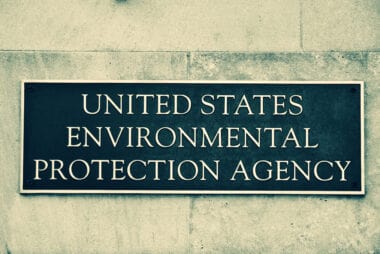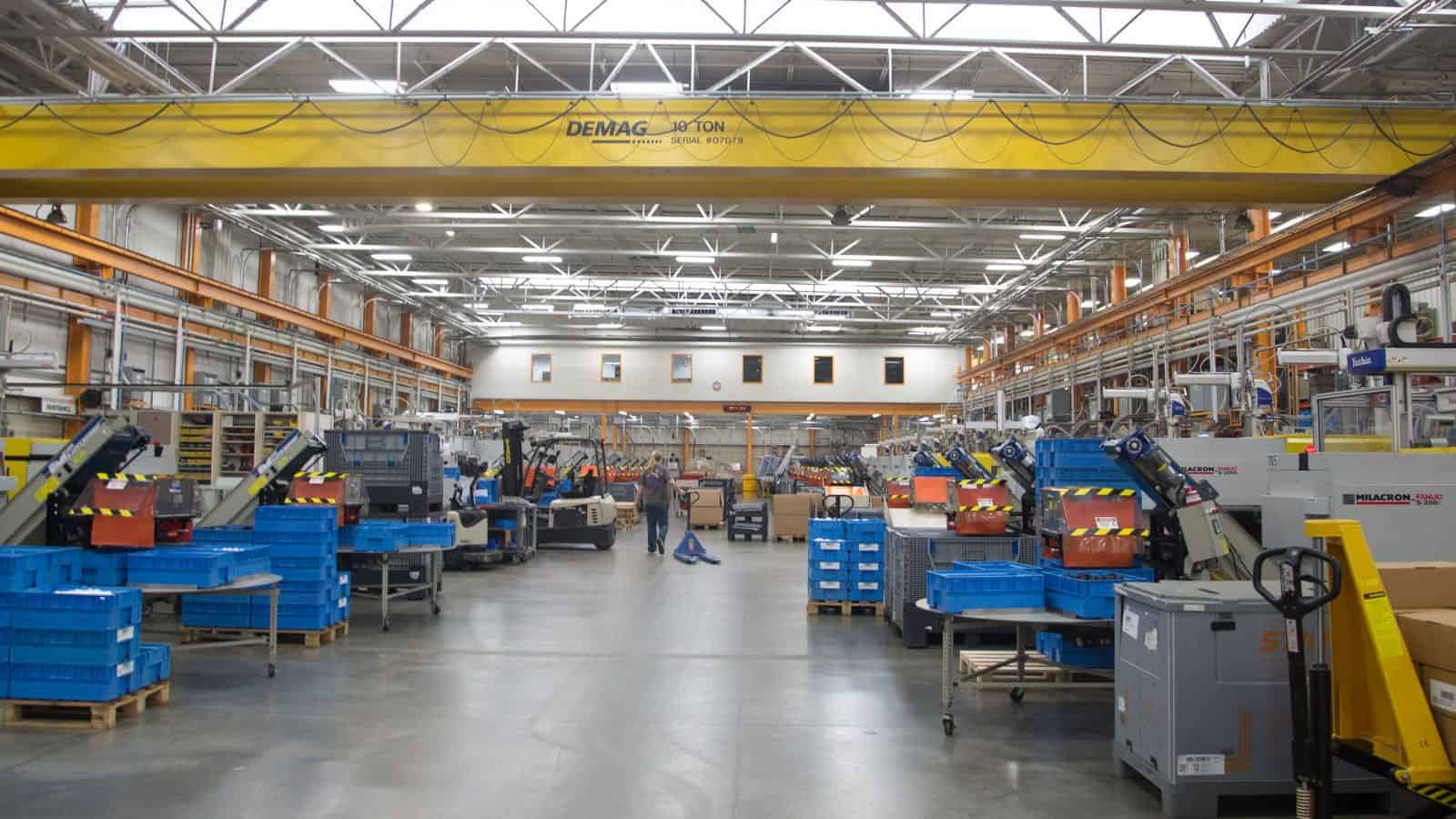EPA Chemical Rule Will Add Delays, Costs for Manufacturers

The EPA recently finalized a rule that establishes a process for conducting risk evaluations for certain chemicals—but it will only hamstring U.S. manufacturing competitiveness if implemented, the NAM said this week.
What’s going on: In a final rule issued late last month under the Toxic Substances Control Act, the EPA “will now consider exposure to chemicals in air and water and, when possible, combined risks from exposure to multiple chemicals” (Chemical & Engineering News).
- “The [agency] will also consider risks to workers without assuming that they are wearing personal protective equipment [and] … chemical uses required for national security or critical infrastructure.”
Why it’s important: The final regulation will unnecessarily cost manufacturers in both time and money.
- The “new TSCA risk evaluation rule adds too many additional barriers and requirements on manufacturers and risks creating de facto bans on chemistries essential to both existing technologies and the development of new innovative materials,” the NAM said Monday.
- “Manufacturing relies heavily on new and existing chemicals, which are the building blocks of technologies that make modern life possible,” NAM Vice President of Domestic Policy Brandon Farris told the agency last December. “To ensure continued access to the newest chemicals which can make essential technologies even more effective and efficient, TSCA should be administered in a manner that protects health and the environment while avoiding unnecessary adverse economic impacts on business enterprises.”
What should be done: The agency should revise the final rule, the NAM said.
Return to Broadband Rules Will Harm Manufacturing Economy

The Federal Communications Commission voted Thursday to restore Obama-era broadband regulations—a move that is outside the agency’s remit and will erode investment in telecom infrastructure, the NAM said.
What’s going on: “The commission voted along party lines to finalize a proposal first advanced in October to reinstate open internet rules adopted in 2015 and reestablish the commission’s broadband authority” (Reuters, subscription).
- The rules, repealed by the Trump administration in 2017, will reclassify broadband as a telecom service under a law originally passed in 1934. This change will subject 21st century high-speed internet to regulations designed for the era of the rotary phone.
- The Biden administration has been seeking a return to the 2015 regulations since 2021, when the president signed an executive order urging the FCC to reinstate them.
Why it’s important: The resuscitated regulations will have a significant and negative impact on the U.S. economy, as historical evidence shows.
- From 2011 to 2022, attempts to impose so-called “net neutrality” restrictions depressed telecom infrastructure investment by $8.1 billion each year, decreased employment by approximately 195,600 jobs and reduced gross domestic product by $145 billion annually (Phoenix Center).
Our view: “Ultimately, [the FCC]’s broadband regulations are a solution in search of a problem,” the NAM wrote in a social post. “The U.S. already has an open and fair internet. This is just the latest in a long line of decisions adding to the regulatory onslaught facing manufacturers in America.”
New Power Plant Rules Unfeasible Without Permitting Reform

Final rules released Thursday by the Environmental Protection Agency to reduce greenhouse gas emissions from traditional fuel-fired power plants are not achievable without permitting reform—and they pose a threat to U.S. national and economic security, the NAM said yesterday.
What’s going on: The new rules, part of President Biden’s pledge to create a carbon-free energy sector by 2035, mandate that:
- Existing coal-fired plants and new natural gas–fired facilities cut or capture 90% of their emissions by 2032;
- Coal-fired plants drastically reduce wastewater runoff and severely tighten the emissions standard for heavy metals; and
- Coal ash—including past deposits “placed in areas that were unregulated at the federal level until now”—be managed in storage ponds.
A first: “The power plant rule marks the first time the federal government has restricted carbon dioxide emissions from existing coal-fired power plants” (Associated Press).
- The new regulations—which face almost certain court challenges—set emissions caps that plant operators would be required to meet.
Targeting major energy sources: Natural gas generates approximately 43% of all U.S. electricity, while coal generates about 16% (AP).
Why else it’s problematic: While manufacturers appreciate that the EPA heeded the input of their industry and did not include existing gas plants in the new requirements, as written the final rules are unattainable because the administration and Congress have not undertaken much-needed, comprehensive permitting reform, according to NAM President and CEO Jay Timmons.
- “Congress and the president have not enacted permitting reform—making it impossible to achieve the EPA’s highly aspirational mandates,” Timmons said. What’s more, the final rules threaten “grid reliability because of the unrealistic timeline for power plants to adopt technologies within the next 10 years that have yet to even be proven at scale.”
- Pushing through yet another set of regulations in the absence of systemic reforms burdens an already overtaxed national electrical grid, jeopardizing U.S. security in a way that “literally could leave Americans in the dark and factories offline.”
What should be done: The EPA should partner with—not undermine—manufacturers “to achieve a more balanced regulatory framework to help reach our climate goals.”
EPA’s Power Plant Rule Is Unachievable Without Substantial Permitting Reform
America’s Energy Security Is Threatened
Washington, D.C. – Following the release of the Environmental Protection Agency’s new regulations on greenhouse gas emissions standards for certain power plants, National Association of Manufacturers President and CEO Jay Timmons released the following statement:
“Manufacturers appreciate the EPA removing existing gas plants from its new regulation, following manufacturers’ warnings about the initial proposal. However, the rest of the rule causes serious concern because Congress and the president have not enacted permitting reform—making it impossible to achieve the EPA’s highly aspirational mandates. We call on Congress to get serious by enacting significant and meaningful permitting reform this year. That is essential to ramping up the use of renewables, carbon capture, hydrogen and nuclear, for example, to meet future demand.
“The final rule threatens grid reliability because of the unrealistic timeline for power plants to adopt technologies within the next 10 years that have yet to even be proven at scale. Our nation should be doing everything possible to make sure our families, businesses and manufacturers have a modern, strong and reliable electrical grid, especially at a time when global turmoil threatens our energy security. This new rule does the opposite, creating a threat to our national and economic security that literally could leave Americans in the dark and factories offline. In short, the EPA is rolling the dice with Americans’ electricity and therefore with President Biden’s manufacturing legacy.
“Our industry has made transformational investments in these technologies and clean energy solutions, and we are leading the way in their deployment. The EPA should be partnering with us—not undermining this progress. We will continue to press the administration to achieve a more balanced regulatory framework to help reach our climate goals.”
-NAM-
The National Association of Manufacturers is the largest manufacturing association in the United States, representing small and large manufacturers in every industrial sector and in all 50 states. Manufacturing employs nearly 13 million men and women, contributes $2.89 trillion to the U.S. economy annually and accounts for 53% of private-sector research and development. The NAM is the powerful voice of the manufacturing community and the leading advocate for a policy agenda that helps manufacturers compete in the global economy and create jobs across the United States. For more information about the NAM or to follow us on Twitter and Facebook, please visit www.nam.org.
Proposed “Right-to-Repair” Exemptions Would Hurt Manufacturers, Consumers

The NAM testified before the U.S. Copyright Office last week, explaining how two proposed exemptions from copyright protections would weaken manufacturers’ intellectual property rights, do significant harm to their businesses and potentially endanger consumers.
What’s going on: The Copyright Office is considering whether to recommend two exemptions from the Digital Millennium Copyright Act that would allow users to circumvent measures protecting copyrighted content.
- One proposal was designed to allow the so-called “right-to-repair” by enabling access to operational data (including diagnostic and telematics data) from automobiles, agricultural vehicles, marine vessels and more. The other is focused on industrial equipment.
NAM speaks out: “The basis of the so-called ‘right-to-repair’ movement hinges on the false notion that owners do not have the ability to repair their own equipment,” NAM Vice President of Domestic Policy Charles Crain said at the recent hearing. “The truth, however, is that the majority of [original equipment manufacturers] already provide a wide range of resources and tools that allow users—and third-party repair businesses—to maintain, diagnose and repair products.”
- The NAM previously submitted comments urging the Copyright Office not to adopt the proposed exemptions.
Why it’s important: “These exemptions would undermine manufacturers’ IP rights in service of right-to-repair—and the record does not support their adoption,” Crain continued.
- The exemptions are too broad and inadequately defined, and their proponents have “failed to show that users will be adversely affected absent the ability to circumvent [copyright law].”
- What’s more, the exemptions “would expose proprietary information to public consumption and use, likely endangering consumers and allowing for unlawful modifications of government-mandated safety and emissions limits.”
The last word: “In short, right-to-repair is a solution in search of a problem,” Crain said.
PFAS CERCLA Designation Will Harm Manufacturing

In a move that will hinder the growth of manufacturing in the U.S., according to the NAM, the Environmental Protection Agency on Friday designated two widely used chemicals as hazardous substances under the Comprehensive Environmental Response, Compensation and Liability Act, or Superfund law, Law360 (subscription) reports.
What’s going on: The addition of two per- and polyfluoroalkyl substances, or PFAS, to the federal list “means the EPA can investigate and clean up releases of the chemicals and ensure that leaks, spills and other releases are reported. Under CERCLA, the government and other parties can sue for contributions to cleanups and to recover costs related to those actions.”
- The newly added PFAS are perfluorooctanoic acid, or PFOA, and perfluorooctanesulfonic acid, or PFOS. PFAS have been used across industries for decades for their unmatched ability to douse fires and resist corrosion, stains and grease.
- The news comes the same month the EPA announced the first-ever national regulation limiting PFAS levels in drinking water to near-zero levels.
What’s in it: “The rule requires entities to immediately report releases of PFOA and PFOS that meet or exceed the ‘reportable quantity’ to the National Response Center, state or tribal emergency response commission, and the local or tribal emergency planning committee, according to the EPA.”
Why it’s problematic: “[T]his unprecedented use of CERCLA authority by the EPA will only hamper President Biden’s vision of growing the manufacturing sector in the U.S.,” NAM Managing Vice President of Policy Chris Netram said, adding that manufacturers support smart efforts to remove harmful substances from the environment.
- “The unique and unmatched chemical bond of these compounds means that there are no existing replacements for the critical products they make up.”
- Furthermore, the overly broad designation of PFOA and PFOS as hazardous “will make it harder for our industry to create innovative products and jobs.”
Manufacturers: Unprecedented Use of CERCLA Authority Will Hamper President’s Manufacturing Vision
Washington, D.C. – Following the release of the Environmental Protection Agency’s rule designating perfluorooctane sulfonic acid, also known as PFOS, and perfluorooctanoic acid, also known as PFOA, as hazardous substances under the Comprehensive Environmental Response, Compensation and Liability Act, National Association of Manufacturers Managing Vice President of Policy Chris Netram released the following statement:
“Manufacturers support efforts to mitigate harmful chemicals from impacting our environment and the health of our nation, but this unprecedented use of CERCLA authority by the EPA will only hamper President Biden’s vision of growing the manufacturing sector in the U.S. The unique and unmatched chemical bond of these compounds means that there are no existing replacements for the critical products they make up.
“The NAM is not opposed to commonsense regulations of PFAS chemicals, and manufacturers are committed to environmental stewardship, while recognizing in many cases we will need to continue to use these chemicals for the foreseeable future. However, designating these compounds as hazardous substances is a blunt, overreaching decision that will make it harder for our industry to create innovative products and jobs.”
-NAM-
The National Association of Manufacturers is the largest manufacturing association in the United States, representing small and large manufacturers in every industrial sector and in all 50 states. Manufacturing employs nearly 13 million men and women, contributes $2.89 trillion to the U.S. economy annually and accounts for 53% of private-sector research and development. The NAM is the powerful voice of the manufacturing community and the leading advocate for a policy agenda that helps manufacturers compete in the global economy and create jobs across the United States. For more information about the NAM or to follow us on Twitter and Facebook, please visit www.nam.org.
FTC to Unveil, Vote on Noncompete Ban Next Week

The Federal Trade Commission will vote next week on the final version of a rule that would prohibit noncompete agreements between employers and their employees, Law360 (subscription) reports.
What’s going on: “According to the FTC’s announcement, the agency’s five commissioners will vote April 23 on whether to ‘authorize public disclosure of the proposed final rule,’ first unveiled in draft form in January 2023. Assuming a vote in the affirmative, staffers will give a presentation on the rule, followed by a second vote to issue the rule in its final form.”
- The agency did not indicate which, if any, changes it has made to the previous version of the rule.
- The FTC received more than 26,000 comments on the rule during the 90-day public comment period.
Why it’s important: A noncompete ban would cause disruption to the majority of manufacturing operations in the U.S., a 2023 NAM survey found.
- Some 70% of manufacturers in the U.S. use noncompete agreements, and they do so to safeguard intellectual property, sales information, industrial processes and business strategies.
- Approximately 66% of survey respondents—representing manufacturers of all sizes—said a ban would interfere with their operations.
- Around 50% of those polled said a ban would have a negative effect on their investment in employee training programs.
The NAM says: “The FTC’s proposed rule severely threatens manufacturers’ ability to protect intellectual property and responsibly invest in their employees,” said NAM Director of Transportation, Infrastructure and Labor Policy Max Hyman.
- “The NAM remains engaged on this critical issue for our members and will weigh our options in response to the commission’s vote next week.”
NAM: EPA’s National PFAS Drinking Water Standard Threatens Manufacturing

Municipal water systems will soon be required to remove six types of per- and polyfluoroalkyl substances, or PFAS, from drinking water, The New York Times (subscription) reports.
- But the move could backfire and have adverse effects on manufacturers, the NAM said Thursday.
What’s going on: The Environmental Protection Agency on Wednesday announced the first-ever national rule limiting PFAS “to near-zero levels.”
- PFAS are compounds that have been used for decades due to their rare ability to douse fires and resist grease, corrosion and stains. They’re found in everything from semiconductors to medical devices and renewable-energy production equipment.
- But under the new mandate water systems across the U.S. will have three years to monitor the chemicals and a further two years to put into place technology to reduce the compounds’ levels in the water.
- The utilities “would be required to notify the public and reduce contamination if levels exceeded the new standard of 4 parts per trillion for [PFOA and PFOS]. Previously, the agency had advised that drinking water contain no more than 70 parts per trillion of the chemicals.”
The background: The rule comes just over a year after the EPA proposed the first federal limits on two PFAS chemicals, known as PFOA and PFOS.
The funding: The 2021 Bipartisan Infrastructure Law set aside $9 billion to help communities with PFAS removal. The government will make $1 billion of it available to states and territories to help defray the cost of testing and treatment over the next few years.
Higher prices, less security: The new standard is wholly infeasible, NAM Managing Vice President of Policy Chris Netram said, and will lead to cost increases throughout the supply chain and make our national defense more difficult.
- “In many instances, there is no viable alternative for these chemicals, and companies may be forced to change plans dramatically” to comply with the new rule, he said. “The severity of the proposed regulations will mean higher prices for everything—community water and waste systems, medical treatments and electronics. More alarming, the regulations will make it more difficult to produce the equipment our military needs to defend our nation.”
What we’re doing: The NAM is weighing legal options for reversing the final rule, according to Netram.
Senate Approves NLRB “Joint Employer” Repeal Proposal

The Senate this week approved a resolution to repeal the National Labor Relations Board joint employer rule, Reuters (subscription) reports.
What’s going on: In a 50–48 vote Wednesday, the Democrat-controlled Senate passed a Congressional Review Act resolution to block an NLRB “rule that would treat companies as the employers of many of their contract and franchise workers and require them to bargain with those workers’ unions.”
- President Biden pledged to veto the resolution, which the House approved in January. A veto would send the measure back to Congress, where it appears to lack the necessary votes for an override.
- The CRA “allows Congress to repeal agency rules through a majority vote in both houses.” The president must sign the resolution for it to take effect.
- The rule was scheduled to go into effect in February but was blocked by a federal judge in Texas. The NLRB is considering options in response to the decision.
What it would do: “The rule would treat companies as ‘joint employers’ of contract and franchise workers when they have control over key working conditions such as pay, scheduling, discipline and supervision, even if that control is indirect or not exercised.”
Why it would be problematic: The NLRB requirement would lead to confusion about which businesses should be considered employers, “disrupting franchising and routine contracting arrangements,” according to another Reuters article.
The NAM says: The joint employer rule would “harm manufacturers at a time when they need the flexibility and contingency offered through temporary and contract workers to best manage supply chain impacts, demand for manufactured products and other inflationary challenges,” the NAM told the NLRB in December.
